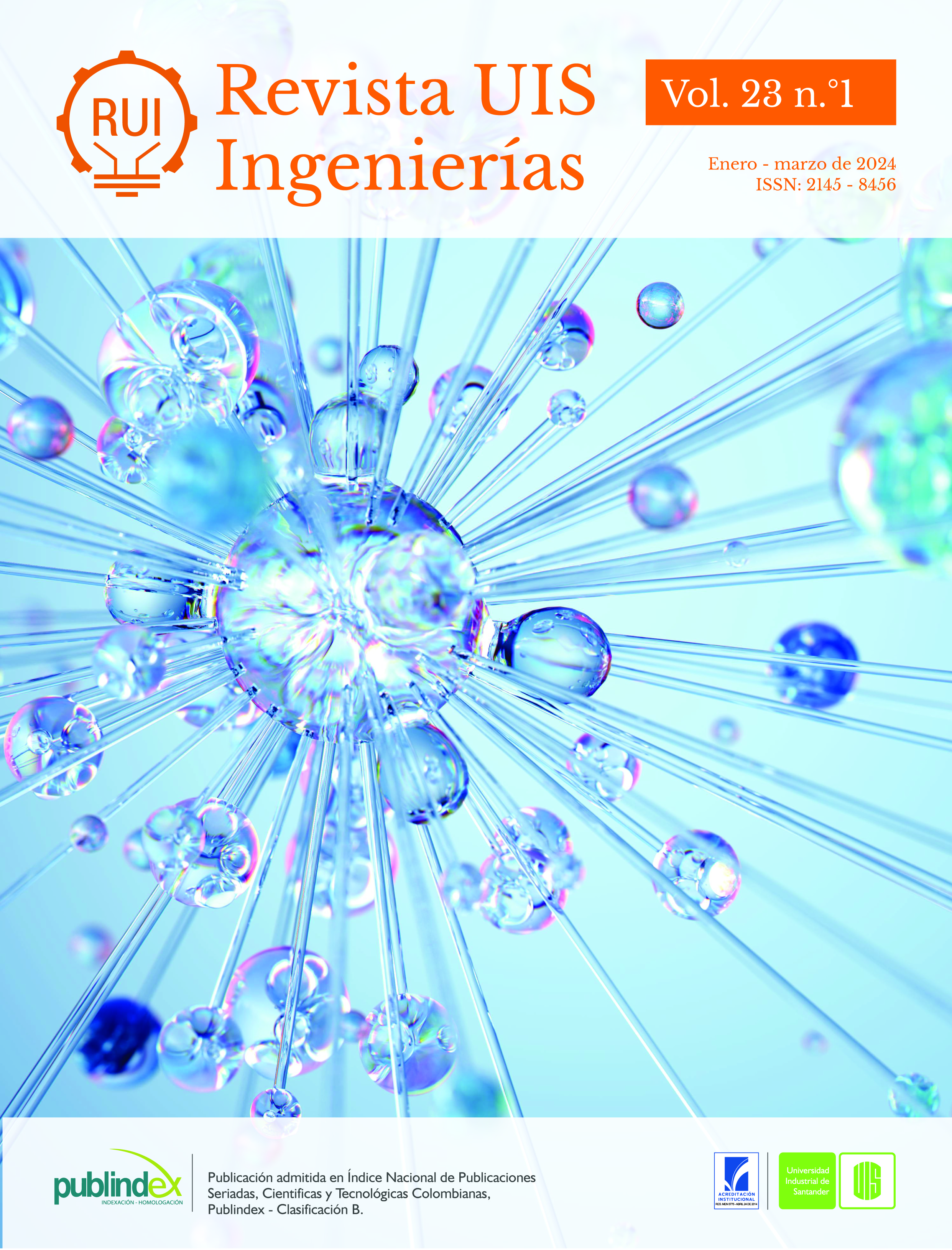Approach to the Conceptual Design of Smart Road Management: A Reference to Public-Private Partnership Models
Published 2024-04-16
Keywords
- Smart Roads,
- Digital Twins,
- Road Asset Management,
- PPP Business Invesment Management
How to Cite
Copyright (c) 2024 Revista UIS Ingenierías

This work is licensed under a Creative Commons Attribution-NoDerivatives 4.0 International License.
Abstract
The research recognizes the importance of road infrastructure in the economic and social development of countries. These projects are capital intensive and have a long-life cycle; Its operation/exploitation stage is complex to manage, due to information asymmetry during the stages of the economic horizon; such novelty constitutes the problem to be solved in asset management. The solution at the conceptual design level incorporates comprehensive information models and “Digital Twins” technology along with artificial intelligence and industry 4.0 algorithms, which allows optimizing the strategic decision process. Then, based on the current situation of technological transformation of the infrastructure sector, a business management model is proposed that offers an environment for making informed decisions to all agents/actors. This technological challenge is assumed with the “Design Science Research” methodology to model a business scheme that tends to strengthen missional processes, in response to the risks of information governance of road assets, in Public-Private Partnership business models, under the “Project Finance” modality. The proposed technological integration maximizes the generation of value of the facilities, in economic, social and sustainable development terms, with the ultimate objective of improving people's quality of life. The conceptual design provides a knowledge base for the Basic Engineering of the model and advance in the “Smart Roads” paradigm, in correspondence with the guidelines of the Sustainable Development Goals.
Downloads
References
- G. Choclán, M. Soler, R, González, “Introduccion a la metodología BIM”, Spanish Journal of Building Information Modeling., vol. 1, no.14, pp. 4-10, 2014.
- B. Fuentes, Impacto de BIM en el proceso constructivo español. Malaga, España: Servicios y comunicación LGV S.L., 2014.
- S. Azhar, M. Hein, B. Sketo, “Building Information Modeling (BIM): Benefits, Risks and Challenges”, McWhorter School of Building Science, Auburn University, 2008.
- H. Sleiman, L. Burdi, “BIM Guidelines for vertical and horizontal construction”, Massachusetts Port Authority. Capital Programs and Environmental, vol. 1, no. 4, pp. 1–72, 2015.
- T. Serebrisky, A. Suarez-Alemán, D. Margot, M, Ramírez, “Financing Infrastructure in Latin America and the Caribbean: How, ¿How Much and by Whom?”, IDB, vol 1, pp. 1-30. 2015, doi: https://doi.org/10.18235/0000212
- J. F. Bravo, “Financiación de proyectos de infraestructura vial de cuarta generación (4g) en Colombia”, trabajo fin de master, Departamento de Economía, Universidad de los Andes, 2015.
- J. Gémez., “BIM for management and maintenance”, 2016. [En línea]. Disponible en: https://www.bimcommunity.com/news/load/230/bimpara-la-gestion-y-el-mantenimiento
- B. Hardin, D. McCool, BIM and Construction Management. Estados Unidos: Wiley, 2015.
- Deusto Formación, “¿Qué es y para qué sirve el modelado paramétrico en la tecnología Bim?”, 2018. [En línea]. Disponible en: https://www.deustoformacion.com/blog/bim-autocadrevit/que-es-para-que-sirve-modelado-parametricotecnologia-bim
- N. Kartam, R. Levitt, “Intelligent Planning of Construction Projects”, Journal of Computing in Civil Engineering, vol. 4, no. 2, pp. 155–176, 1990, doi: https://doi.org/10.1061/(ASCE)08873801(1990)4:2(155)
- M. Toro, “La Planificación: Características y Desarrollo del Proceso Resumen”, Políticas de Planificación y Supervisión Educativa, Universidad Santa Maria, 2012.
- O. Van Damme, H. Van Geelen, P. Courange, “The Evaluation of Road Infrastructure Development Projects”, Transportation Research Procedia, vol. 14, pp. 467–473, 2016, doi: https://doi.org/10.1016/j.trpro.2016.05.099
- Área de Proyectos del ILPES/CEPAL, “Guía Metodológica para la Identificación, Formulación y Evaluación de Proyectos de Infraestructura Vial en Costa Rica”, Ministerio de Planificación Nacional y Política Económica, San José, 2012
- M.C. Mazuera, “Gerencia de Planeación Para la Infraestructura Vial Nacional”, monografía, Universidad Militar Nueva Granada, 2014.
- J. Fountain, S. Langar, “Building Information Modeling (BIM) outsourcing among general contractors” Automation in Construction, vol. 95, pp. 107–117, 2018, doi: https://doi.org/10.1016/j.autcon.2018.06.009
- M. Albis, “Ciclos y fases de la identificación de proyectos”, Universidad del Norte, 2012.
- L. Sierra., “Gestión de proyectos de construcción con metodología BIM (Building Information Modeling)”, monografía, Universidad Militar Nueva Granada, 2016.
- The Institute of Asser Management, “The SelfAssessment Methodology Plus”, 2015.
- M. Macchi, I. Roda, E. Negri, L. Fumagalli, “Exploring the role of Digital Twin for Asset Lifecycle Management”, IFAC-PapersOnLine, vol. 51, no. 11, pp. 790-795, 2018, doi: https://doi.org/10.1016/j.ifacol.2018.08.415
- F. Tao, M. Zhang, Y. Liu, A. Nee, “Digital twin driven pronostics and health management for complex equipment”, CIRP Annals, vol. 67, no. 1, pp. 169-172, 2018, doi: https://doi.org/10.1016/j.cirp.2018.04.055
- Committee of Transport Officials (COTO), “Draft TMH 22: Road Asset Management Manual”, South Africa, 2013.
- M. Ouertani, A. Parlikad, D. Mcfarlane, “Towards an Approach to Select an Asset Information Management Strategy”, International Journal of Computer Science and Applications, vol. 5, no. 3, pp. 25 - 44, 2008.
- D. Broo, J. Schooling, “Digital twins in infrastructure: definitions, current practices, challenges and strategies”, International Journal of Construction Management, vol. 23, no. 7, pp. 1254–1263, 2021, doi: https://doi.org/10.1080/15623599.2021.1966980
- Y. Tchana, G. Ducellier, S. Remy, “Designing a unique Digital Twin for linear infrastructure lifecycle management”, Procedia CIRP, vol. 84, pp. 545-549, 2019, doi: https://doi.org/10.1016/j.procir.2019.04.176
- A. Hevner., “A Three Cycle View of Design Science Research”, Scandinavian Journal of Information Systems, vol. 18, no. 2, pp. 87-92, 2007, doi: https://aisel.aisnet.org/sjis/vol19/iss2/4/
- A. Hevner., et al., “Design Science in Information Systems Research,” MIS Quarterly, vol. 28, no. 1, pp. 75-105, 2004, doi: https://doi.org/10.2307/25148625

